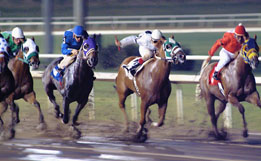Lesson 3
1. Lesson 3
1.2. Explore
Module 3: Permutations, Combinations, and the Fundamental Counting Principle
Explore

Jupiterimages/ Photos.com/Thinkstock
In Try This 1, you discovered different ways of calculating the number of permutations: you used lists, tree diagrams, and the fundamental counting principle. You also calculated the number of arrangements when you used all the tiles and when you only used some of the tiles.
Another way to calculate the number of permutations is by drawing blanks to represent the problem.
In how many ways can horses finish first, second, and third if there are 10 horses in the race?
You can draw blanks to represent finishing first, second, and third.
![]()
Assuming every horse is equally likely to win, you know that the first position can be filled in 10 ways, the second-place finisher could be any of the 9 remaining horses, and, finally, the third-place finisher could be any of the remaining 8 horses. Applying the fundamental counting principle, the number of ways the first, second, and third place positions could be filled is 10 × 9 × 8 or 720 different ways.
Notice that the order of the finish is important. If horses A, B, and C finish in that order, it is a different result from a finish of C, B, and A—even though the arrangement contains all the same horses.
Try This 2
You know that if you are trying to find the number of ways all 10 horses could finish, it would be 10! = 10 × 9 × 8 × 7 × 6 × 5 × 4 × 3 × 2 × 1. Because you are only interested in the first three places, you only have 10 × 9 × 8. Is there a way to represent this in factorial notation?
- Why are only three terms, 10 × 9 × 8, used to find the solution?
- The expression 10 × 9 × 8 is no longer multiplied by the remaining factors, 7 × 6 × 5 × 4 × 3 × 2 × 1. Explain a process that can be used to remove these factors.
- Write 7 × 6 × 5 × 4 × 3 × 2 × 1 in factorial notation.
- Write 10 × 9 × 8 as a quotient using factorial notation.

- Determine an expression for the denominator that uses the total number of horses, 10, and the number 3 that represents finding the first, second, and third finishers.
![]() Save your responses in your course folder.
Save your responses in your course folder.
Share 1
With a group or partner, share your solutions to questions 4 and 5. How do your quotients compare?
Based on your solution to question 5, find a general expression for the number of permutation of n objects arranged r at a time.
![]() If required, place a summary of your discussion in your course folder.
If required, place a summary of your discussion in your course folder.